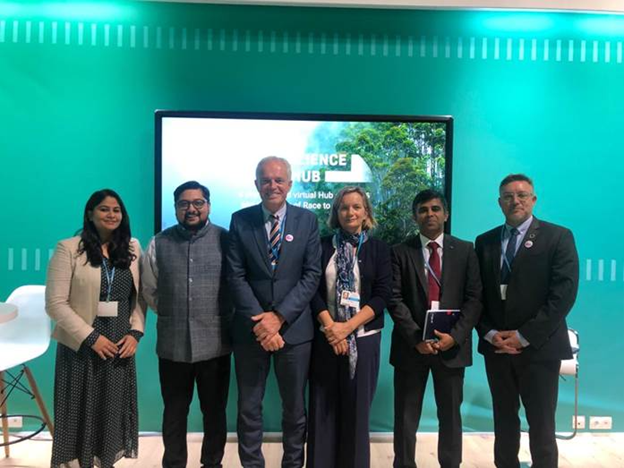- +91-11-4044-5999
- info@cdri.world
-
Copernicus Marg, New Delhi, INDIA

- The session was held on 5 November 2021 at 1030-1130 GMT at the Resilience Hub, COP26, Glasgow, the United Kingdom
- The session focussed on challenges and key actions at different stages of a project life cycle for Nature-based Solutions (NbS) in the context of resilient infrastructure
- The session marked the release of a white paper on ‘Governance of Infrastructure for Resilience,’ developed by Coalition for Disaster Resilient Infrastructure (CDRI) and Resilience Shift, in partnership with Arup (https://www.cdri.world/sites/default/files/publication/WhitePaperonGovernanceofInfrastructureforResilience.pdf)
New Delhi, 5 November 2021: The Coalition for Disaster Resilient Infrastructure (CDRI), today, hosted a session on ‘Pioneering Nature-based Solutions for Resilient Infrastructure’ at the Resilience Hub, 2021 United Nations Climate Change Conference (COP26), Glasgow, the United Kingdom. The session discussed key learnings from case studies around the world and on the incorporation of recommended actions into NbS projects in complementarity with other grey infrastructure initiatives. The session also marked the release of a white paper on ‘Governance of Infrastructure for Resilience,’ developed by Coalition for Disaster Resilient Infrastructure (CDRI) and Resilience Shift, in partnership with Arup.
The session was moderated by Tanaji Sen, Director, Advocacy and Partnerships, CDRI while the announcement of the white paper was made by Riya Rahiman, Senior Specialist- Infrastructure Resilience, CDRI. The panelists included Sven Kramer, Director Sustainability, Van Oord; UnniKrishnan Divakaran Nair, Head of Climate Change, Commonwealth Secretariat; Dr. Emily Pidgeon, Vice President of Ocean Science and Innovation, Conservation International and Seth Schultz, Executive Director, Resilience Shift.
According to Sven Kramer, Director Sustainability, Van Oord, “It is important to include all benefits in the valuation of a project to increase the likelihood that nature-based infrastructure is more attractive than grey infrastructure. An example here is of sand dunes, which do more for less and also have much higher revenues, mainly from recreation and tourism, compared with the grey alternative.”
UnniKrishnan Divakaran Nair, Head of Climate Change, Commonwealth Secretariat talked about ensuring country ownership in mainstreaming nature-based solutions. “For this, the Commonwealth has the Blue Charter Initiatives and the Commonwealth’s Living Lands Charter (soon to be launched) to integrate nature-based solutions; costing of resilience in terms of green and grey infrastructure is cheaper; we need to have different financial instruments to look at nature-based solutions to secure livelihoods and protect nature; knowledge management is important to learn from each other replicate models such as the Hub & Spokes model; and finally capacity building and enhancement of government officials around this is imperative.”
Setting the business case for investing in green-grey infrastructure Dr. Emily Pidgeon, Vice President of Ocean Science and Innovation, Conservation International opined that “Green-grey infrastructure is significantly cheaper and has numerous additional benefits.” She added that “Analyzing social and environmental benefits of green-grey infrastructure shows that if we bring back half the mangroves, it will lead to more productive fisheries, increase biodiversity, and other tangible benefits such as reducing wildlife interference with the roadways etc., ultimately producing much higher resilience for the whole community.”
Seth Schultz, Executive Director, Resilience Shift stated that “In order to protect, preserve and restore the natural environment, nature-based solutions need to be central in international agreements. We must be a part of the implementation process that we are seeing in the Nationally Determined Contributions (NDCs). There needs to be a much greater linkage between the layers of governments – national to regional to local.”
Stressing on the role of NbS in infrastructure resilience, Tanaji Sen, Director, Advocacy and Partnerships, CDRI, said that “Green and blue integrated infrastructure provides more absorptive and adaptation capabilities. We live in an unpredictable environment with climate extremes and uncertainties. Nature-based Solutions allow more breathing space, both literally and figuratively.”
Speaking about nature-based solutions that span large landscapes and seascapes, Riya Rahiman, Senior Specialist- Infrastructure Resilience, CDRI, said that “Nature-based Solutions pose significant challenges and opportunities at every stage of the infrastructure project life cycle that requires more open-ended and non-linear governance approaches.”
Over the past decade, NbS have emerged as an effective mechanism to boost resilience and meet some of the extra costs required for resilient infrastructure planning. In the face of climate related-uncertainties, NbS are a seemingly pragmatic way forward, to adapt to climate variabilities as compared to static grey infrastructure solutions like concrete seawalls, levees, dams, embankments, etc. They are widely regarded as important tools for climate adaptation and disaster risk reduction around the world. They attempt to deliver economic, societal, and environmental co- benefits by promoting biodiversity and providing diverse ecosystem services, and they are designed to handle various environmental concerns in a resource-efficient and flexible manner. They also offer several chances for stakeholders and civil society to participate actively, such as in the co-creation and co-design of potential solutions.
About CDRI:
Launched by Hon. Prime Minister Shri Narendra Modi at the UN Climate Action Summit at New York on 23 September 2019, the Coalition for Disaster Resilient Infrastructure (CDRI) is a partnership of national governments, UN agencies and programmes, multilateral development banks and financing mechanisms, the private sector, and knowledge institutions that aims to promote the resilience of new and existing infrastructure systems to climate and disaster risks in support of sustainable development.